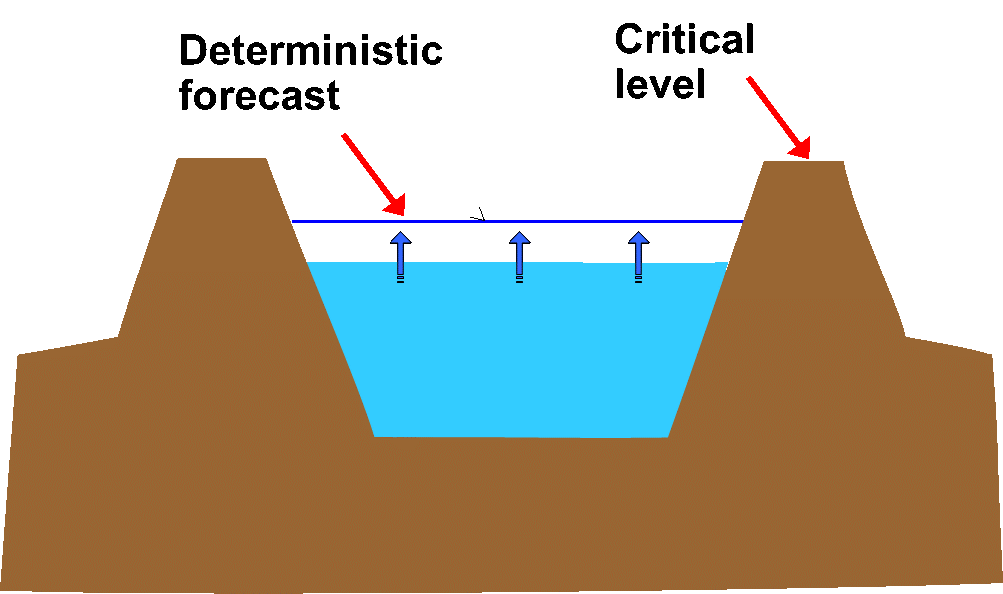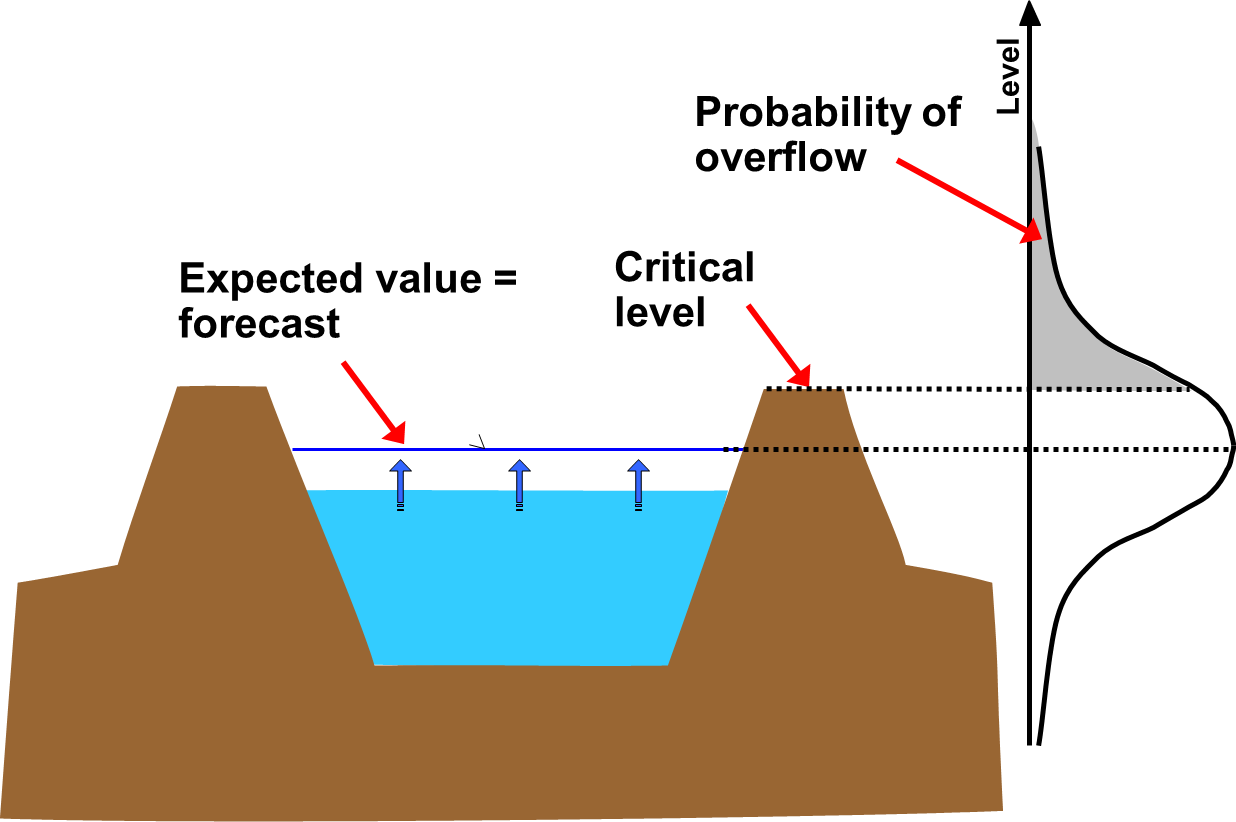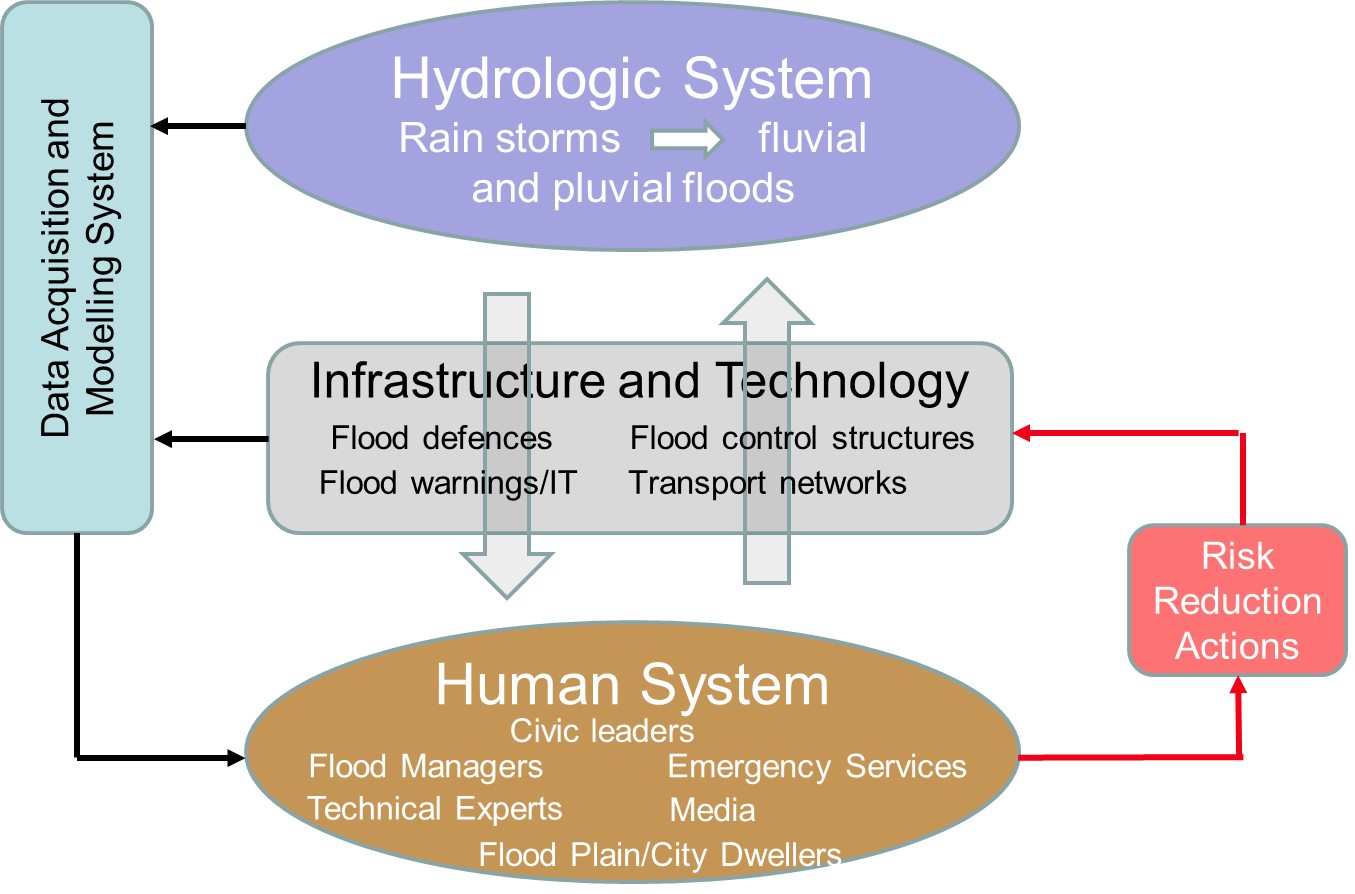Issues
Issue 1: Decision Making Under Uncertainty
Deterministic forecasting is the traditional operational approach. Consider the situation in Figure 1, in which a deterministic forecast is made for a river with a dyke. The forecast level is less than the critical level, hence a warning is not issued.

Figure 1. Deterministic forecast
In Figure 1, the forecast is considered as 'real', but forecasts are a 'virtual reality'. Consider the following question: Flood damages will occur:
- when the forecasted water level overtops the dykes?
- when the actual future water level overtops the dykes?
The obvious answer is (2), i.e. when the actual future water level overtops the dykes.
in addressing (2) an appropriate question that a flood manager will wish to address is: What is the probability of the dykes being overtopped? This question recognises that there is uncertainty on future occurrences, which is termed 'predictive uncertainty':
"Predictive uncertainty is defined as the probability of occurrence of a future value of a predictand (such as water level, discharge or water volume) conditional on prior observations and knowledge as well as on all the information one can obtain on that specific future value, which is typically embodied in one or more hydrological/hydraulic model forecasts" (Krzysztofowicz, 1999).
Predictive uncertainty is usually expressed through a probability density function PDF. Figure 2 shows the same river system but with a PDF representing the uncertainty in the predicted level. The decision of whether to warn may be different with the inclusion of probabilistic information.

Figure 2. Probabilistic forecast.
Figure 3 demonstrates how predictive uncertainty can be used to derive the probability density function. (This is the simplest definition of predictive uncertainty as we have not included a representation of the flood forecasters' prior knowledge.) Each dot in the figure represents a forecast and the corresponding observation over a historical period. The scatter between the two sets of values is due to uncertainty in the model, the parameter values, and the forcing data.
Let us run our forecasting system to provide a prediction ŷ of the future water level y. (This could equally apply to a rainfall value). The forecast ŷt is depicted by the red vertical line. Hence the forecast value is known, but we do not know what will actually occur. However, we can use our forecast to estimate the conditional probability of the future value. The conditional density is obtained by cutting the joint density.
 Figure 3. Evaluating predictive uncertainty
Figure 3. Evaluating predictive uncertainty
The probability density of what will occur, conditional upon the knowledge of the model forecast ŷ :

References
Krzysztofowicz R. Bayesian theory of probabilistic forecasting via deterministic hydrologic model. Water Resources Research. 1999 Sep;35(9):2739-50.
Todini E. (2009) Predictive uncertainty assessment in real time flood forecasting. In: Baveye P.C., Laba M., Mysiak J. (eds) Uncertainties in Environmental Modelling and Consequences for Policy Making. NATO Science for Peace and Security Series C: Environmental Security. Springer, Dordrecht. https://doi.org/10.1007/978-90-481-2636-1_9
Issue 2: Human dimension of decision-making
The human dimension of decision-making in managing floods, and of citizen responses to warnings, is largely missing from modelling frameworks. However, decision-making takes place within a complex Coupled Human and Hydrologic System (CHAHS), Figure 4. The Human and Hydrologic System components represent social and hydrologic processes, both of which are characterised by complexity, spatial heterogeneity, organization, and temporal variability. These two systems interact as a consequence of the occurrence of hydrological events, with Infrastructure and Technology interventions mitigating the impacts of the hydrologic system events. The two systems coevolve over time as a consequence of hydrologic events and the Responses to them.

Figure 4. Coupled Human and Hydrologic System
The hierarchy of various levels of actors involved in the Human System include:
- High Level: Civic leaders, flood managers, emergency service managers. Issue RRAs (flood warnings, evacuations, operation of major flood control structures, etc.)
- Tactica Level: Civil defence/flood management/emergency services. Implement high-level decisions, ‘on the ground’ operational decisions, etc
- Citizen Level: Individuals/households/businesses. Respond to warnings, evacuation orders, etc
There is a complex flow of information and data between actors, which creates a major challenge (Drobot, 2007), Table 1. To improve flood warnings, there is a need to understand the efficiency of the flow of information between actors, and how actors respond to information.
Table 1. Actors and information sources
| Actor | Information and data |
| Flood forecaster | Weather information/forecasts |
| Flood managers | Flood forecasts |
| Emergency services | Weather and flood data |
| Floodplain dwellers | Public weather/flood forecasts, flood warnings, information from emergency services |
Agent-Based Modelling
In previous work, researchers at Newcastle University developed a dynamic agent-based model (ABM) of flood incident management processes (Dawson et al., 2011). The model uses Geographical Information System representations of topography, buildings and road networks, and empirical survey data was used to characterise communities. The ABM was coupled with a hydrodynamic model to estimate the vulnerability of citizens to flooding under different storm surge conditions and evacuation strategies. This approach could be adapted to support flood emergency planning and appraise the benefits of flood incident management measures for urban flooding. A Youtube video of the model is available here.
References
(2007) Advances and challenges in flash flood warnings, Environmental Hazards, 7:3, 173-178




